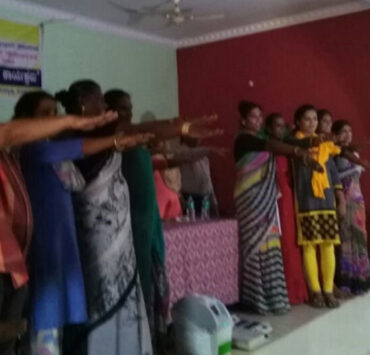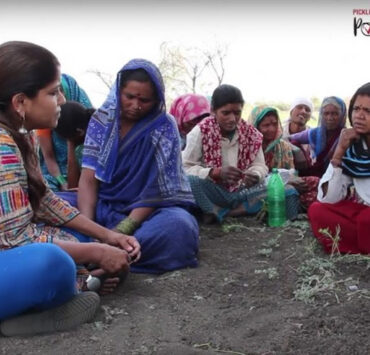
By Aimee Pandit
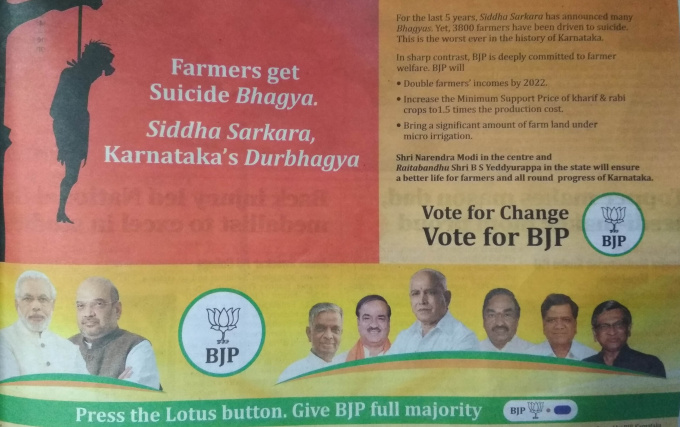
Ahead of the Assembly elections in Karnataka on 12 May, the two major rivals, the Congress Party and the Bharatiya Janata Party (BJP), have been trading punches through an ad blitzkrieg. The print ads, placed strategically – either on Page 1 (usually below the mast head ) or on the City pages of most newspapers – do not mince words in their attacks against each other. On 5 May the BJP’s political ads took over from the customary commercial ads that now often precede the front page in almost all the newspapers published in Bangalore.
While the first few ads from the Congress and the BJP assailed each other on failure of governance, they changed tack immediately after the rape and murder of a little girl in Kathua made headlines. Suddenly the safety and security of women and girls became a stick with which to beat the adversary.
The BJP’s ad talked of how the incumbent Congress government in the state had failed to create safe spaces for women: “Women and children gripped by anxiety and fear. Siddha Sarkara is in deep slumber.” The Congress shot back with, “In Jammu, BJP Ministers rallied in favour of the rape accused. Will you still say you are with rape victims when your people do the opposite? BJP Government we want answers.” The BJP’s repartee the next day was this: “Modi Sarkara punishes child rapists with death penalty, Siddha Sarkara still asleep.”
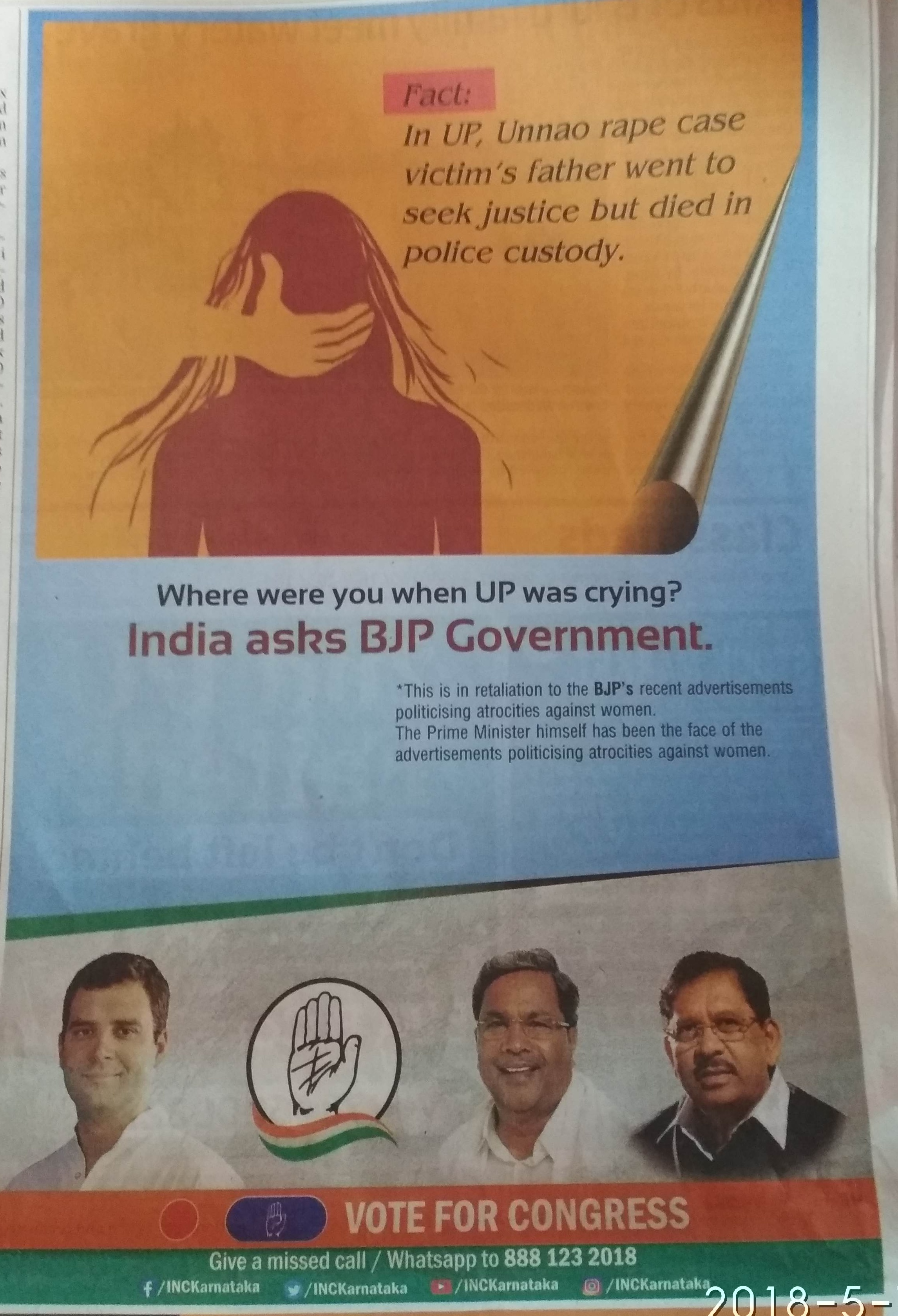 The safety and security of women theme dominated the ads for a while.
The safety and security of women theme dominated the ads for a while.
The next day, a teaser ad from the BJP said this: “10% commission Sarkara makes Karnataka No 1 in corruption.” On the inside page the ad went on to quote a survey and list Karnataka as “No 1 in goondaraj, crime, killing lakes, potholes, floods of sewage, garbage mess and crimes against women and children.” Other ads from the BJP made digs at the steel flyover project initiated by the Karnataka government to much opposition from the public, calling it “Siddha Sarkara’s many ways to steal.” On 1 May the BJP’s ad bringing to light farmer suicides had a graphic silhouette of a farmer’s corpse hanging from a tree. (See above)
Acting on a complaint by the Karnataka Pradesh Congress Committee (KPCC), the Media Certification and Monitoring Committee (MCMC) banned three video advertisements by the BJP against the ruling Congress, on the grounds that they violated the Election Commission’s guidelines. The video ads were titled ‘Jana Virodhi Sarkara’ (anti-people government), ‘Viphala Sarkara’ (failed government) and ‘Mooru Bhagya’ (three fortunes).
The Congress filed another complaint with the EC against the BJP on 4 May for publishing false and misleading advertisements in newspapers, saying it maligned the image of Congress party president Rahul Gandhi and Karnataka CM Siddaramaiah.
While the copy in the ads from both parties is a copy editor’s delight (clunky sentences, random and unnecessary capital letters), what stands out are the large images of Prime Minister Narendra Modi and BJP party president Amit Shah on one side of the ads and BS Yeddyurappa, the party’s Chief Ministerial candidate from Karnataka, on the right. The Congress ads generally have Rahul Gandhi and Siddaramaiah in the same frame. The ads were big on accusations against opponents until recently; it was only close to the end of April that they began to highlight each party’s plans for the state.
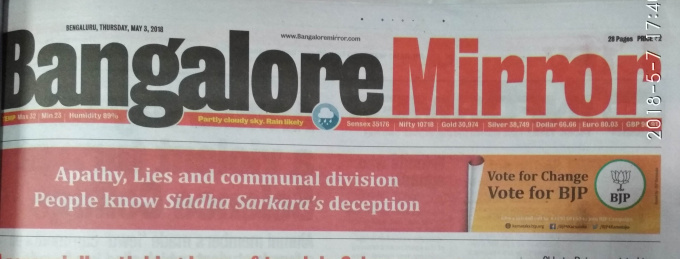 Front page teaser ads like this greet readers of most newspapers every morning.
Front page teaser ads like this greet readers of most newspapers every morning.
The ads are clearly a progression from the slugfest that has been on between the Congress and the BJP, with Modi calling the incumbent government the Sidda Rupaiya Sarkar (a twist on Siddaramaiah’s name and an implication that his government works only for money). Rahul Gandhi added to the slugfest by saying that Modi has brought the Gabbar gang to the state (a nod to the popular movie, Sholay, which was shot near Bengaluru).
Only when the manifestos were launched did the conversation turn to some affirmative action. If election campaigns are similar to marketing pitches made to win contracts, why are they so negative? Why do they focus only on the failures of the opponent and not on one’s own game plan? Marketing gurus have always said that bad mouthing competition is one of the lowest tactics that one can be employed. Clearly the strategists for political parties do not seem to think so.



